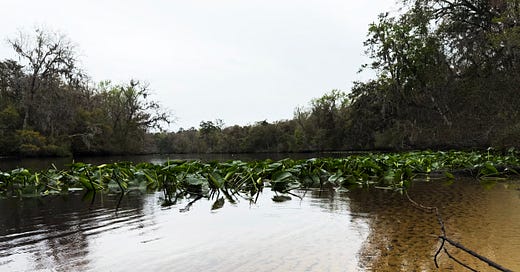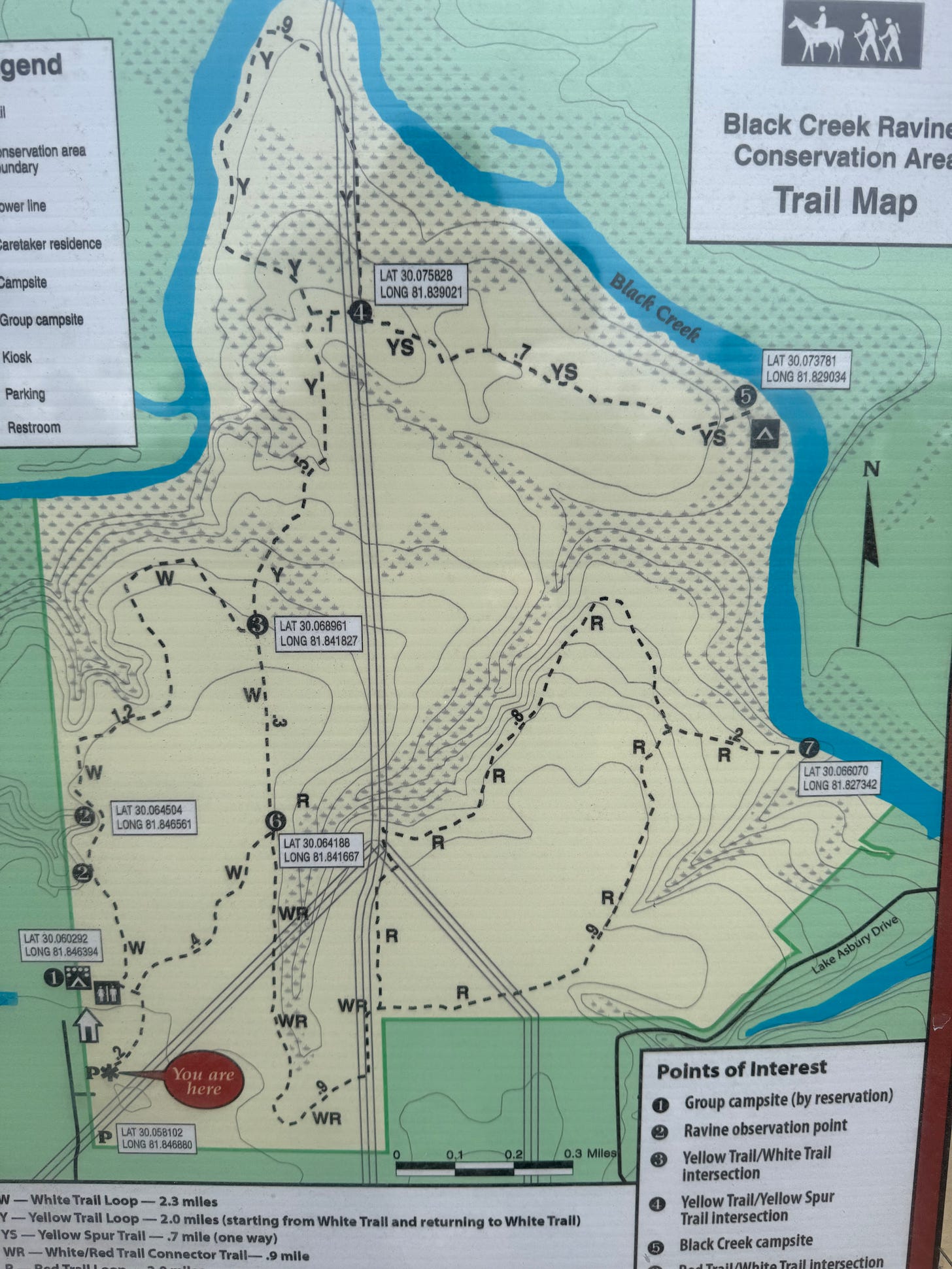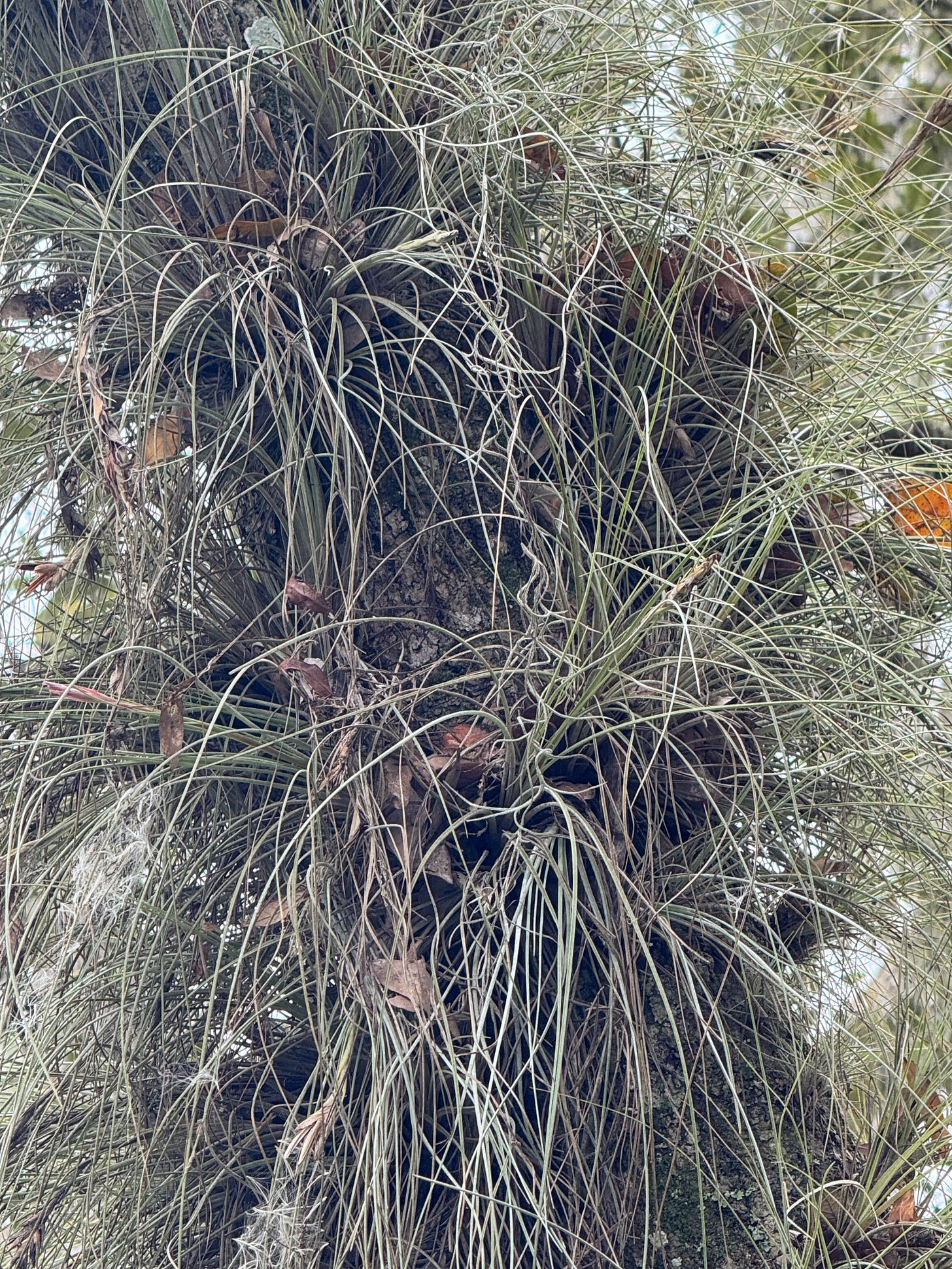March 13, 2025. Thursday evening. 11:56 pm EDT. The full worm moon moves toward a total eclipse. As we watch and the light of the sun becomes totally blocked by the shadow of planet earth the moon turns a bloody brownish red. Thus it is referred to as a blood moon. This being the cycle known as the Worm Moon, we are safe to call it the Bloody Worm Moon. I’m sure some late night libation establishment has concocted a special craft cocktail. I’ll most likely miss that.
I went on a hike last Saturday with the Worm Moon on my mind. Black Creek Ravines is a piece of conservation land maintained by the St. Johns River Water Management District. It lies just east of Middleburg, Florida in Clay County. The property holds more than five miles of well-kept trails and offers views from a high sand bluff over the Black Creek.
Legend holds that the indigenous peoples who lived thousands of years along these shores referred to the creek as White Creek (translation unknown.) Who knows, but it is a good story. The same story tells that the Europeans could only see the dark water and not the reflection of the sky. The yin and yang of our universal vision probably offers the completed tale.
Trail map, Black Creek Ravines.
The day was a bit overcast. A front started rolling in as the morning progressed. A dewey drizzle sprinkled enough to make my wide-brimmed hat sag here and there.
The sandy trail follows the ridge of an ancient dune formation. Lack of nutrition keeps vegetation less lush. Typical Longleaf Pine (Pinus palustris), Saw Palmetto (Serenoa repens), Gallberry (Ilex glabra), and Wiregrass (Aristida stricta) form the ruling class of this scrubby ecosystem.
A favorite note of this trail is the fact that at points the bluff offers a view into the tops of trees. I like this because of the various epiphytic plants along the way. The elevation allows up-close inspection of the epiphytes.
Of course the various Tillandsia species are abundant but if the hiker hits it just right they may come into contact with a special treat, face-to-face. Several years ago I ran into the sly Green Fly Orchid (Epidendrum magnoliae) and communed face-to-face. It’s a treat for the early summer hiker, for sure. This time I only saw a few of the typical flat leaves. I’m afraid the bounteous plants from the past fell victim to poachers.
Green Fly Orchid (Epidendrum magnoliae) Black Creek Ravines
I hiked on. A few hundred yards after leaving the bluff there’s a short path downhill off the trail that offers a white sand beach under a power line. Usually when I hike this trail in the summer it’s crowded with drunken revelers. This day being overcast and cool with a little moisture in the air left an empty beach. There was a perfect shelf near the water where I could comfortable sit, watch and write.
I had run up on a Limpkin (Aramus guarauna) just before I walked down to the beach. Waited in a stillness to see if the wading bird would venture toward me. A speedboat rounded the bend throwing a drowning wake up on to the shore. Birds were gone. I lifted my feet out of the water.
I conjured the Worm Moon. Put my hands palm down on the tufts of spent grass to feel the subterranean stirrings of Spring. Two clumps of Dog Fennell and a sprig of Toadflax let me know that energy was brewing. My mind’s ears let me hear the writhing and wriggling in the soil. Spring was on its way.
Traditionally, the Worm Moon calls out for honoring the planet and celebrating the arrival of Spring in the Northern Hemisphere. For most of us access to well-managed public lands are the only access to the wilds we have.
Wild violets on the Black Creek.
So here we are in March of 2025. The disasters of the last six months hover close in our winter-sleepy noggins. Thoughts of Spring offer us a bit of hope. Tight buds on the hardwoods are swelling. The early flowering wild shrubs explode with their vernal show.
I am always delighted to see our southern matriarch, Pinxter Azalea (Rhododendron canescens.) The fragrant pink flowers floated through the woods the entire walk. They soothe a worried mind for sure.
Along with bring us hope the Worm Moon cautions us to be patient. Late Winter and early Spring are a time of unsettled weather. We learn sad lessons during times of transition. Sit by the water and watch the Limpkins feed on Apple Snails. Time will buffer the trials and tribulations of disquieted times.
By observing nature in all its glory we know that good will win. Nature will own the final victory. Hopefully observation will show us that our best path is to cooperate with the natural order and support our existing ecosystems. If we comply with those stirrings just under the soil we will revel in a new burst of energy and our species will survive another cycle around the sun.
I’ll see your reflection Thursday evening. Don’t let the bloody orb send scare you. It’s fleeting. Spring is on its way.












Great read!